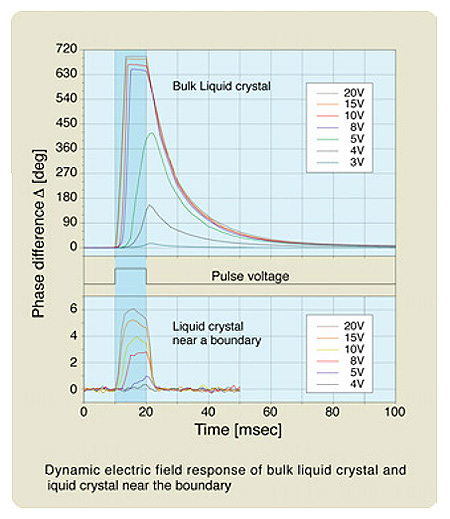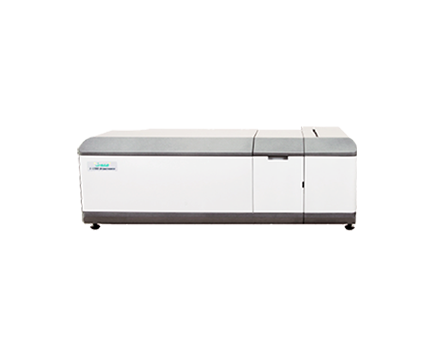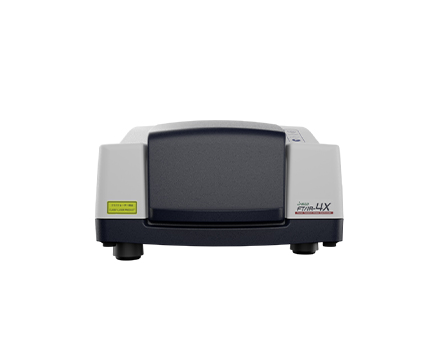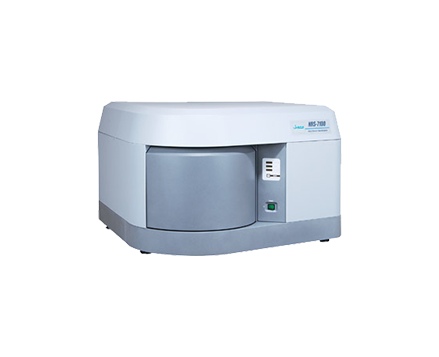Time-Resolved Measurements of Liquid Crystals
August 23, 2022
Introduction
Generally, the behavior of liquid crystal molecules in the vicinity of an orienting layer is different from the behavior of bulk liquid crystal. It is said to be influenced by an anchoring effect that works between the orientation film and liquid crystal molecules. Measuring the electric field response of the liquid crystals is indispensable to understanding this orientation mechanism.
The M-200 series enables time-resolved analysis of liquid crystals using the high-speed data acquisition of the PEM dual lock-in system. The figure shows an example of the dynamic electric field response of a nematic liquid crystal in bulk and crystals near the boundary. The measurement used a 5CB liquid crystal cell (orientation: parallel: cell thickness: 8.17 µm) doped with 6 wt% p-dimethylaminoazobenzene. First the bulk liquid crystal’s electric field response in a transmission configuration is measured at a wavelength (698 nm) where the dye is transparent, and then the electric field response of the liquid crystal near the boundary is measured in a reflective configuration (dye-doped reflection method*) at the DAB absorption peak wavelength (419 nm). Comparing the time-resolved measurement results for the bulk liquid crystal and the liquid crystal near the boundary as shown in the figure, one can observe that their electric field responses are quite different.

The dye-doped reflection method makes it possible to suppress the light reflected from a liquid crystal cell’s back surface and then measure the electric field response of the liquid crystal near the anchoring interface by doping dye in the liquid crystal cell and then applying the reflection ellipsometry at the absorption wavelength.1-3
References
Tadokoro, Fukazawa, and Toriumi. Preliminary Draft of the 22nd Draft of the 44th Spring Term Applied Physics Society, 30aSNL-11 (1997).
Tadokoro, Akao, Kimura, Akabane, Ono, and Toriumi. Preliminary D Panel Discussions on Liquid Crystals, 1AO6 (1996).
Ono, Akabane, Kimura, Tadokoro, Akao, and Toriumi. Preliminary draft of the 44th Spring Term Applied Physics Society, 30aSNL-12 (1997).
Featured Products:

Time-Resolved Measurements of Liquid Crystals
Introduction
Generally, the behavior of liquid crystal molecules in the vicinity of an orienting layer is different from the behavior of bulk liquid crystal. It is said to be influenced by an anchoring effect that works between the orientation film and liquid crystal molecules. Measuring the electric field response of the liquid crystals is indispensable to understanding this orientation mechanism.
The M-200 series enables time-resolved analysis of liquid crystals using the high-speed data acquisition of the PEM dual lock-in system. The figure shows an example of the dynamic electric field response of a nematic liquid crystal in bulk and crystals near the boundary. The measurement used a 5CB liquid crystal cell (orientation: parallel: cell thickness: 8.17 µm) doped with 6 wt% p-dimethylaminoazobenzene. First the bulk liquid crystal’s electric field response in a transmission configuration is measured at a wavelength (698 nm) where the dye is transparent, and then the electric field response of the liquid crystal near the boundary is measured in a reflective configuration (dye-doped reflection method*) at the DAB absorption peak wavelength (419 nm). Comparing the time-resolved measurement results for the bulk liquid crystal and the liquid crystal near the boundary as shown in the figure, one can observe that their electric field responses are quite different.

The dye-doped reflection method makes it possible to suppress the light reflected from a liquid crystal cell’s back surface and then measure the electric field response of the liquid crystal near the anchoring interface by doping dye in the liquid crystal cell and then applying the reflection ellipsometry at the absorption wavelength.1-3
References
Tadokoro, Fukazawa, and Toriumi. Preliminary Draft of the 22nd Draft of the 44th Spring Term Applied Physics Society, 30aSNL-11 (1997).
Tadokoro, Akao, Kimura, Akabane, Ono, and Toriumi. Preliminary D Panel Discussions on Liquid Crystals, 1AO6 (1996).
Ono, Akabane, Kimura, Tadokoro, Akao, and Toriumi. Preliminary draft of the 44th Spring Term Applied Physics Society, 30aSNL-12 (1997).

 Download This Application
Download This Application

